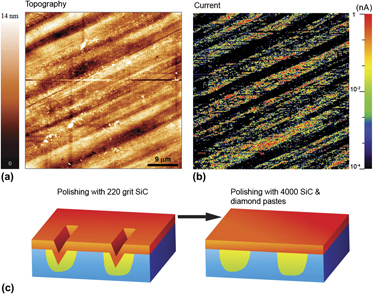Crossref Citations
This article has been cited by the following publications. This list is generated based on data provided by
Crossref.
Souier, Tewfik
Santos, Sergio
Al Ghaferi, Amal
Stefancich, Marco
and
Chiesa, Matteo
2012.
Enhanced electrical properties of vertically aligned carbon nanotube-epoxy nanocomposites with high packing density.
Nanoscale Research Letters,
Vol. 7,
Issue. 1,
Souier, Tewfik
Stefancich, Marco
and
Chiesa, Matteo
2012.
Characterization of multi-walled carbon nanotube–polymer nanocomposites by scanning spreading resistance microscopy.
Nanotechnology,
Vol. 23,
Issue. 40,
p.
405704.
Guo, L.Q.
Lin, M.C.
Qiao, L.J.
and
Volinsky, Alex A.
2014.
Duplex stainless steel passive film electrical properties studied by in situ current sensing atomic force microscopy.
Corrosion Science,
Vol. 78,
Issue. ,
p.
55.
Diamanti, M.V.
Souier, T.
Stefancich, M.
Chiesa, M.
and
Pedeferri, M.P.
2014.
Probing anodic oxidation kinetics and nanoscale heterogeneity within TiO2 films by Conductive Atomic Force Microscopy and combined techniques.
Electrochimica Acta,
Vol. 129,
Issue. ,
p.
203.
UZUN, İsmail
GÜLER, Buğra
ÖZYÜREK, Taha
UÇARLI, Okan
BODRUMLU, Emre
and
MENEK, Necati
2014.
Steel and Nickel Titanium Endodontic Instruments.
International Journal of Electrochemical Science,
Vol. 9,
Issue. 10,
p.
5812.
Guo, L.Q.
Yang, B.J.
Liang, D.
and
Qiao, L.J.
2015.
Surface preparation effect on duplex stainless steel passive film electrical properties studied by in situ CSAFM.
Journal of Materials Research,
Vol. 30,
Issue. 20,
p.
3084.
Seita, Matteo
Nimerfroh, Michael M.
and
Demkowicz, Michael J.
2017.
Acquisition of partial grain orientation information using optical microscopy.
Acta Materialia,
Vol. 123,
Issue. ,
p.
70.
Guo, L. Q.
Qin, S. X.
Yang, B. J.
Liang, D.
and
Qiao, L. J.
2017.
Effect of hydrogen on semiconductive properties of passive film on ferrite and austenite phases in a duplex stainless steel.
Scientific Reports,
Vol. 7,
Issue. 1,
Yakubov, Vladislav
Lin, Meichao
Volinsky, Alex A.
Qiao, Lijie
and
Guo, Liqiu
2018.
The hydrogen-induced pitting corrosion mechanism in duplex stainless steel studied by current-sensing atomic force microscopy.
npj Materials Degradation,
Vol. 2,
Issue. 1,
Srinivasan, N.
and
Kumaran, S. Senthil
2019.
Role of Alloy Chemistry on Stability of Passive Films in Austenitic Stainless Steel.
Journal of Materials Engineering and Performance,
Vol. 28,
Issue. 6,
p.
3695.
Krawiec, Halina
and
Vignal, Vincent
2021.
Mechanical and Electro-Chemical Interactions Under Tribocorrosion.
p.
7.
Ahn, Taemin
and
Kim, Tae-Hwan
2023.
Microscopic conductivity of passive films on ferritic stainless steel for hydrogen fuel cells.
Journal of the Korean Physical Society,
Vol. 83,
Issue. 4,
p.
289.
魏, 雨希
2023.
Effect of Milling Residual Stress on Stress Corrosion of Al7075-T6 Alloy.
Modeling and Simulation,
Vol. 12,
Issue. 03,
p.
2141.
Lee, So-Hyeon
Lee, Junsang
Kim, Younghoon
and
Kim, Ju-Young
2024.
Surface residual stress in H-section steel beams processed by quenching and self-tempering using instrumented indentation testing.
Journal of Materials Research and Technology,
Vol. 32,
Issue. ,
p.
177.


